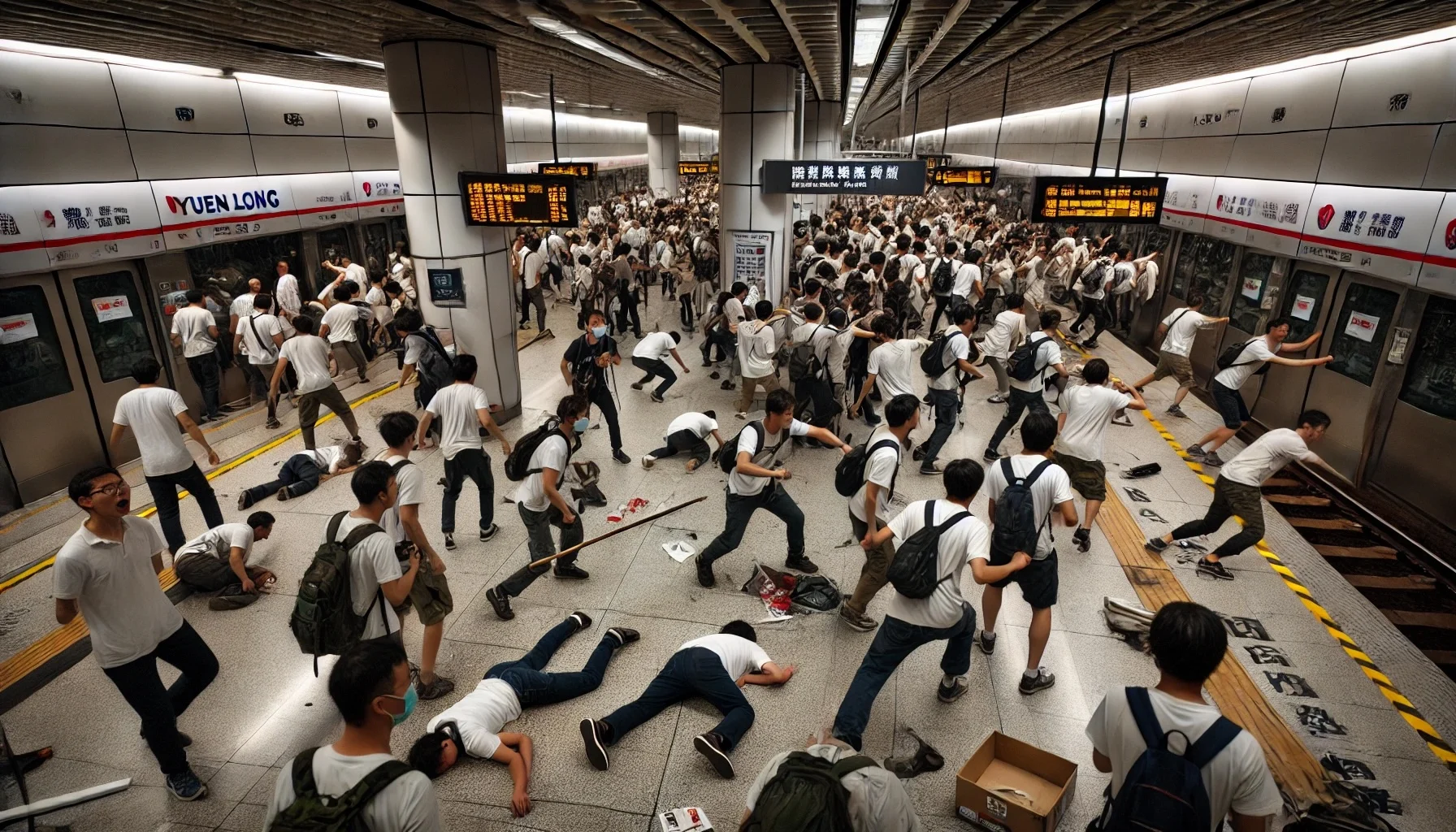
The Yuen Long Attack
by: The Calamity Calendar Team
July 21, 2019
Background and Lead-Up
The year 2019 was a turbulent one for Hong Kong. The city was engulfed in protests triggered by a proposed extradition bill that many feared would erode Hong Kong’s autonomy by allowing extraditions to mainland China. These protests, which started in March, quickly grew into a broader movement demanding democratic reforms and resisting Beijing’s increasing influence. The protests frequently led to violent clashes between demonstrators and the police, setting the stage for one of the most infamous incidents of that tumultuous year.
On July 21, 2019, a significant protest had taken place on Hong Kong Island. Protesters had marched from Causeway Bay to Sheung Wan, and by the evening, the atmosphere across the city was charged with tension. As the protesters dispersed, no one could foresee the horror that was about to unfold in the relatively quiet district of Yuen Long.
The Night of the Attack
Late Evening, July 21, 2019
Around 10:00 PM, a group of men dressed in white shirts began to gather at the Yuen Long MTR station. These men, armed with sticks and metal rods, initially caused unease among the commuters and residents present. Their presence at the station seemed ominous, and as the minutes ticked by, their intentions became horrifyingly clear.
Thanks for subscribing!
10:30 PM
Without warning, the white-clad men launched a brutal assault on the people in the station. They attacked indiscriminately, targeting anyone in their path, including commuters, bystanders, and journalists. The attackers seemed to particularly focus on those they believed were returning from the earlier protest on Hong Kong Island, but many of the victims were ordinary citizens uninvolved in the protests. The violence was shocking and relentless, leaving a trail of injured and terrified individuals in its wake.
11:00 PM
As videos of the attack started to circulate on social media, the scale of the violence became widely known. These videos showed scenes of chaos and horror, with bloodied victims lying on the station floor. Desperate calls for police assistance were made by the victims and witnesses, but help was slow to arrive.
11:30 PM
Despite the urgent pleas, the police response was notably delayed. Officers arrived at the scene about 30 minutes after the violence began but did not immediately intervene to stop the attacks. This delayed response sparked widespread criticism and led to allegations that the police were colluding with the attackers. Some attackers were even seen leaving the scene without being apprehended.
Midnight and Early Hours of July 22
The violence continued sporadically into the early hours of the next day. Victims sought refuge wherever they could, hiding in shops and other buildings while waiting for police assistance and medical help. The night of terror left at least 45 people injured, including journalists and a pregnant woman. Miraculously, no deaths were reported.
The Aftermath
Property Damage
Aside from the damage within the MTR station, there were no significant reports of property damage. However, the psychological impact on the victims and the wider community was profound.
Injuries and Deaths
The attack resulted in at least 45 injuries. The brutality of the assault, coupled with the delayed police response, led to a deep sense of insecurity and mistrust among the public.
Economic Impact
The Yuen Long Attack further heightened the sense of tension and insecurity in Hong Kong. Public trust in the police and the government was severely impacted. The broader protest movement continued, leading to economic disruptions, particularly in the retail and tourism sectors.
Response and Recovery Efforts
Immediate Response
The police faced heavy criticism for their delayed and inadequate response. Allegations of police collusion with the attackers were rampant, further eroding public trust in law enforcement.
Government and Police Accountability
The Hong Kong government and police force were subjected to intense scrutiny following the attack. The Independent Police Complaints Council (IPCC) investigated the incident, but its findings were widely criticized as inadequate. Public confidence in the police and government institutions took a significant hit.
Policy Changes and Legal Actions
The attack spurred calls for police reforms and greater accountability. Some attackers were later arrested and charged, but the slow judicial process and the limited number of prosecutions led to ongoing public dissatisfaction.
Current Knowledge
Today, the Yuen Long Attack remains a highly controversial and sensitive topic in Hong Kong. It is seen by many as a pivotal moment in the 2019 protests, symbolizing the perceived failures of the police and the government to protect citizens. Investigations into the attack and the actions of the police continue to be subjects of public and academic scrutiny. The incident has also influenced ongoing discussions about police accountability, the rule of law, and civil rights in Hong Kong.
The night of July 21, 2019, will forever be etched in the collective memory of Hong Kong as a night of terror and violence. It serves as a grim reminder of the volatility that marked the 2019 protests and the profound impact of those events on the city’s social and political fabric.
Stay in the Loop!
Become a Calamity Insider and get exclusive Calamity Calendar updates delivered straight to your inbox.
Thanks! You're now subscribed.